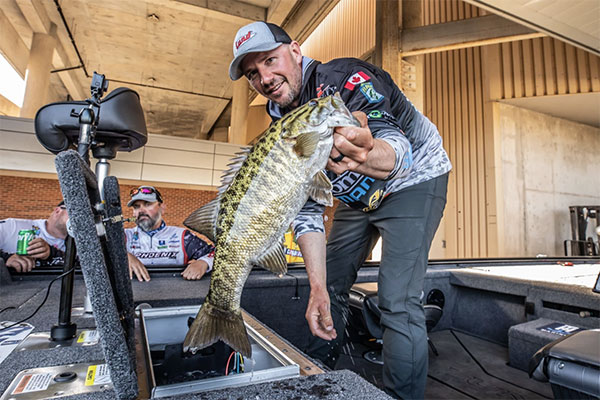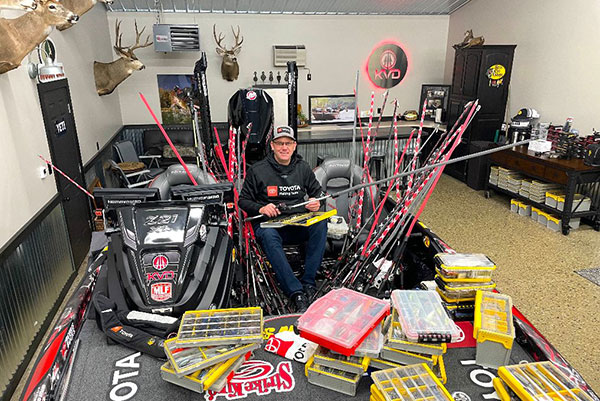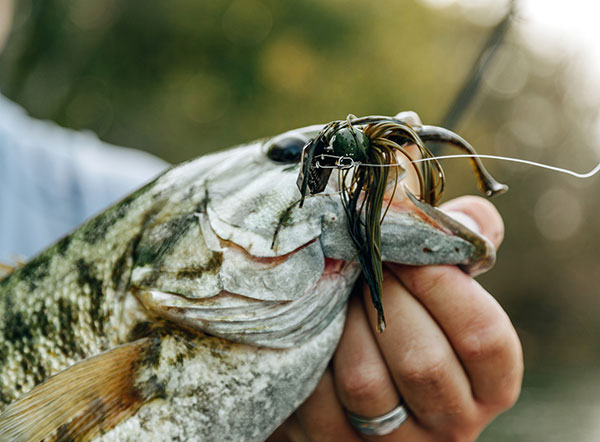- Details
Z-man Report
 Jeff “Gussy” Gustafson
Jeff “Gussy” Gustafson
All three days of the 2023 Bassmaster Classic, Jeff “Gussy” Gustafson stuck to his confidence bait, catching every one of his tournament-winning smallmouth bass on one of two Z-Man baits—a 4-inch smelt-pattern Scented Jerk ShadZ and a similar, though slightly smaller StreakZ™ 3.75. It’s a statement that not only begs questions, but also implies greatness.
“Z-Man’s Scented Jerk ShadZ is one of those rare bass baits that look pretty unassuming tied to your line,” observes Gustafson, who’s won numerous major bass derbies with the same jig and softbait setup. “But put it in the water and it absolutely springs to life, does things few other baits can do; operates on those super subtle levels of body and tail movement, so critical to triggering sight-feeding bass.
Composed of ElaZtech® superplastics, Z-Man’s Scented Jerk ShadZ harbors legit bass catching sorcery—a rare combination of softness, buoyancy, movement and improbable toughness. Specific to Gussy’s Classic gameplan, the bait offers an almost supernatural talent for hovering horizontally in the water column, just barely pulsing its tail like a shad or shiner in full-on chill mode.
- Details
By Al McGuckin
 Kevin VanDam
Kevin VanDam
While bass anglers in the South fish nearly year-round, March marks the unofficial start to fishing season for just about all of America, and preparation is the first step to a successful season. So, Kevin VanDam shares three tackle prep activities he exercises prior to each tournament season to help anglers of all levels have a better year.
Grab a pen. Make a grocery list.
“The first thing I do when I’m getting ready for a new fishing season is grab a notepad and pen. As I sort through all the lures, hooks, and weights, I literally write a list of anything I’m running low on,” says VanDam.
“It’s a simple but efficient way of making sure I’m not missing any of the tackle I’ll use most going into the season, without overstocking or wasting money on things I don’t need,” adds the Team Toyota angler.
- Details
Z-man Report
 Z-man Mini Max
Z-man Mini Max
Behind the scenes, even before anglers tasted success with the ChatterBait JackHammer and its now-legendary bass vibes, the Z-Man architects were already on the water and at the whiteboard, conceiving the next phase of the bladed bass jig. On the magnum end of the hex-blade spectrum, Z-Man pro Bryan Thrift constructed the rod-pulsing Big Blade™ ChatterBait.
Z-Man champion Luke Clausen sang a different bass-attracting tune— a little ditty dedicated to small-fry forage, JackHammer-level lure quality and a slightly different vibe.
The ChatterBait MiniMax is already being heralded as an intelligent fish catching design with bulletproof componentry.
“One of our primary goals in designing the MiniMax was to give anglers a high-performance bladed jig in a compact package that handles big bruiser smallmouths and 5-pound-plus largemouths just as effortlessly as the JackHammer,” says Clausen. “When you examine the MiniMax’s hook, blade, skirt, and overall design, its pro-grade construction comes shining through.”
Bladed Jig Dissection
A tournament-quality bladed jig in a bite-size package, the ChatterBait MiniMax employs a premium heavy-duty 2/0 black-nickel hook for easy jaw penetration and maximum holding power. Dual molded conical keeper barbs lock soft plastic trailers tight to the jig. While wire-tied silicone skirts extend the life of each vibrant strand, even when big bass wolf it down.
As Clausen further explains, the ChatterBait MiniMax performs new and different bladed jig presentations, made possible by the lure’s subtle, refined frame.





